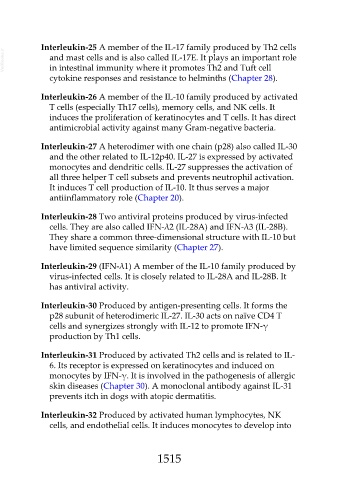Page 1515 - Veterinary Immunology, 10th Edition
P. 1515
Interleukin-25 A member of the IL-17 family produced by Th2 cells
VetBooks.ir and mast cells and is also called IL-17E. It plays an important role
in intestinal immunity where it promotes Th2 and Tuft cell
cytokine responses and resistance to helminths (Chapter 28).
Interleukin-26 A member of the IL-10 family produced by activated
T cells (especially Th17 cells), memory cells, and NK cells. It
induces the proliferation of keratinocytes and T cells. It has direct
antimicrobial activity against many Gram-negative bacteria.
Interleukin-27 A heterodimer with one chain (p28) also called IL-30
and the other related to IL-12p40. IL-27 is expressed by activated
monocytes and dendritic cells. IL-27 suppresses the activation of
all three helper T cell subsets and prevents neutrophil activation.
It induces T cell production of IL-10. It thus serves a major
antiinflammatory role (Chapter 20).
Interleukin-28 Two antiviral proteins produced by virus-infected
cells. They are also called IFN-λ2 (IL-28A) and IFN-λ3 (IL-28B).
They share a common three-dimensional structure with IL-10 but
have limited sequence similarity (Chapter 27).
Interleukin-29 (IFN-λ1) A member of the IL-10 family produced by
virus-infected cells. It is closely related to IL-28A and IL-28B. It
has antiviral activity.
Interleukin-30 Produced by antigen-presenting cells. It forms the
p28 subunit of heterodimeric IL-27. IL-30 acts on naïve CD4 T
cells and synergizes strongly with IL-12 to promote IFN-γ
production by Th1 cells.
Interleukin-31 Produced by activated Th2 cells and is related to IL-
6. Its receptor is expressed on keratinocytes and induced on
monocytes by IFN-γ. It is involved in the pathogenesis of allergic
skin diseases (Chapter 30). A monoclonal antibody against IL-31
prevents itch in dogs with atopic dermatitis.
Interleukin-32 Produced by activated human lymphocytes, NK
cells, and endothelial cells. It induces monocytes to develop into
1515

